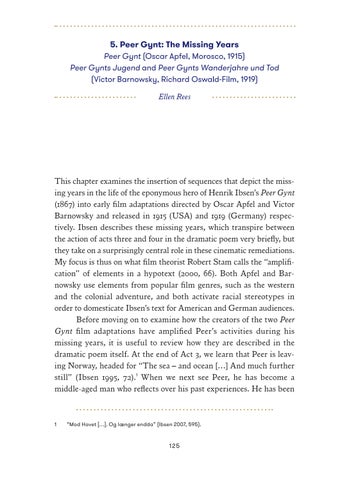5. Peer Gynt: The Missing Years Peer Gynt (Oscar Apfel, Morosco, 1915) Peer Gynts Jugend and Peer Gynts Wanderjahre und Tod (Victor Barnowsky, Richard Oswald-Film, 1919) Ellen Rees
This chapter examines the insertion of sequences that depict the missing years in the life of the eponymous hero of Henrik Ibsen’s Peer Gynt (1867) into early film adaptations directed by Oscar Apfel and Victor Barnowsky and released in 1915 (USA) and 1919 (Germany) respectively. Ibsen describes these missing years, which transpire between the action of acts three and four in the dramatic poem very briefly, but they take on a surprisingly central role in these cinematic remediations. My focus is thus on what film theorist Robert Stam calls the “amplification” of elements in a hypotext (2000, 66). Both Apfel and Barnowsky use elements from popular film genres, such as the western and the colonial adventure, and both activate racial stereotypes in order to domesticate Ibsen’s text for American and German audiences. Before moving on to examine how the creators of the two Peer Gynt film adaptations have amplified Peer’s activities during his missing years, it is useful to review how they are described in the dramatic poem itself. At the end of Act 3, we learn that Peer is leaving Norway, headed for “The sea – and ocean […] And much further still” (Ibsen 1995, 72).1 When we next see Peer, he has become a middle-aged man who reflects over his past experiences. He has been
1
“Mod Havet […]. Og længer endda” (Ibsen 2007, 595).
125
